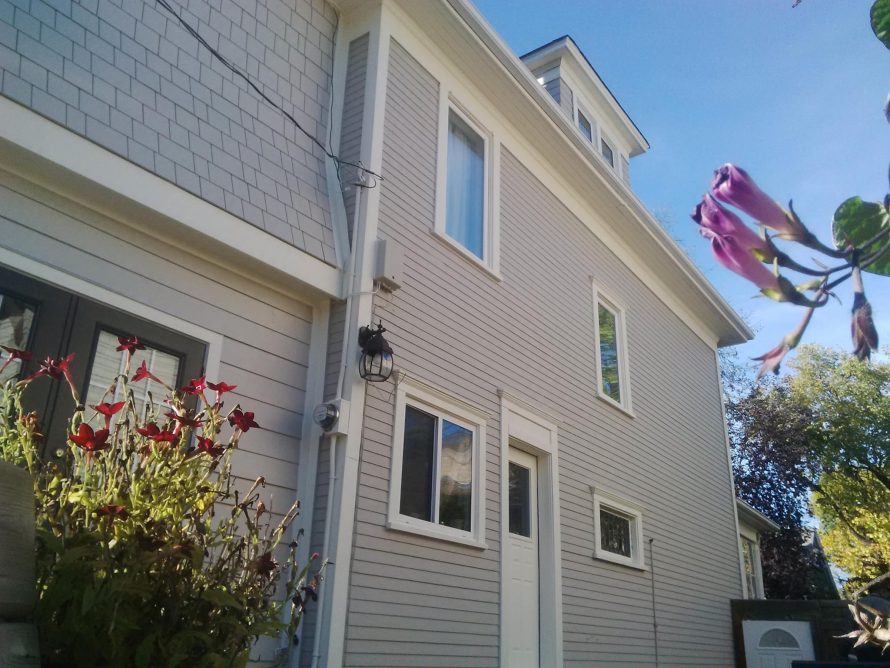The paint on the exterior of your home is your opportunity to make a statement to the world. But more than being an aesthetic statement, exterior paint is a vital part of a building’s integrity, and a key protection for both your home’s structure and its interior against the elements. As painters in Winnipeg, a city where those elements measure among the fiercest on the planet, we’re familiar with the kinds of abuse exterior paint must stand up to, from extreme cold, to blistering sun. We also know that the most important factor in ensuring paint’s longevity is preparation. Preparing a house to receive paint takes place in three steps: Planning, ensuring a sound substrate, and priming. This process can take longer than the process of applying paint, and it begins before any good painter has even picked up a tool.
1. Planning
“Failure to plan is planning to fail.” Whether you attribute this aphorism to Alan Lakein, Winston Churchill, or Benjamin Franklin, we can rest assured that each man first heard it from his own father, caught in a stroke of paternal inspiration. In any case, the truth of the saying applies to painting as much as anything. Painting the exterior of a house without a plan can very literally lead to the best paint failing. There are many environmental concerns that any exterior painter must plan around. Some are obvious, such as not painting in winter, or in the rain. But as surely as cold and wet can doom a paint job to failure before it’s even begun, heat and sun can do the same. The heat and powerful sun of a July day can pose real problems for paint, and it’s important when painting at the height of summer to plot the location of paint application to avoid direct sun. During the height of summer, it can even be necessary to avoid working around solar noon, meaning earlier starts each morning, and sometimes shorter days. Particularly when using darker colours.
And not every paint performs the same in marginal conditions. Winnipeg’s climate can treat us to volatile, unpredictable weather, making spring and fall uncertain times to plan certain paint jobs. While many paints can tolerate surface temperatures as low as 2 degrees Celsius during application, some can’t. Some paints, such as the elastomeric paints popular for stucco painting, also need sustained warmer temperatures during their long curing process.
2. Ensuring a Sound Substrate
Paint is, by design, great at sticking to things. But the stickiest substance in the world could not stay in place if the surface it’s stuck to wasn’t stuck to itself. For example, the strongest paint in the world would not survive a stiff breeze if it were applied on sand. This is because sand has poor internal cohesion, and comes apart under slight forces, like the wind or a cat’s paw. Making sure that the surfaces we paint are cohesive is vital to ensuring that good work done painting isn’t wasted when forces that the paint can survive are exerted on the surface under the paint.
In many cases, the act of scraping away loose and peeling paint is enough to ensure a sound substrate. A paint job that has already failed is obviously a poor surface to receive new paint, but removing the paint that is peeling reveals the sound substrate underneath–as long as that substrate hasn’t already been allowed to break down during prolonged exposure. Winnipeg is a city with a lot of old housing stock, and many houses here have gone decades between paint jobs. This means that the wood substrate on these homes has often been exposed to the elements for more than ten years, leaving it weathered or even decayed. Rotten wood cannot receive paint. Weathered wood can, but we advise a thorough sand in order to remove the weathered surface and expose the sound wood underneath.
We also have other options in our bag of tricks, some of which fall under the third phase of preparation.
3. Priming
There is a broad array of primers on the market, and choosing the right one for your needs is important. Much of what we wrote in our article on choosing an interior primer holds true here, but with different considerations given the harsh conditions exterior surfaces experience, and the breadth of products on the market. There are many popular latex primers that are completely adequate in many scenarios. It’s also true that in most scenarios, when priming wood, you can’t go wrong with an alkyd primer. Certain woods, however, are prone to emitting tannins and moisture, which call for stain blockers or shellac primers. There are specialty primers that function as a last resort in securing substrate cohesion, or can solidify a surface that’s subject to chalking. There are even paints specially designed for older, rougher substrates that work without primer. Some substrates, such as masonry in some scenarios, rarely call for priming. In these cases, priming can prove, at best, a waste of time and, at worst, counter-productive.Do you have any questions about the prep necessary before painting the exterior of your house? Give us a shout, we’ll be happy to let you know exactly what you need.


